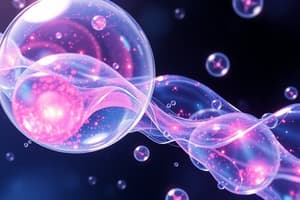Podcast
Questions and Answers
What type of extruder was used for the synthesis process?
What type of extruder was used for the synthesis process?
- Continuous flow mixer
- Batch reactor
- Pilot twin-screw extruder (correct)
- Single-screw extruder
What was the main advantage of sodium hydroxide in the reactions discussed?
What was the main advantage of sodium hydroxide in the reactions discussed?
- It is less efficient than other reagents
- It reacts at lower concentrations
- It requires higher temperatures for effectiveness
- It is faster and more efficient than solution reactions (correct)
At what angle of incidence was the diamond crystal equipped for the analysis?
At what angle of incidence was the diamond crystal equipped for the analysis?
- 45 degrees (correct)
- 60 degrees
- 30 degrees
- 90 degrees
What was the analytical grade percentage of sodium hydroxide used?
What was the analytical grade percentage of sodium hydroxide used?
What does ATR stand for in the context of the spectra obtained?
What does ATR stand for in the context of the spectra obtained?
Which software was used for processing the ATR spectra?
Which software was used for processing the ATR spectra?
What type of material was synthesized in the study mentioned?
What type of material was synthesized in the study mentioned?
What feature of the twin-screw extruder was specifically mentioned?
What feature of the twin-screw extruder was specifically mentioned?
What is the molecular weight of chitosan mentioned in the content?
What is the molecular weight of chitosan mentioned in the content?
What degree of acetylation (DA) does chitosan possess?
What degree of acetylation (DA) does chitosan possess?
Which alternative method is used for the mechanochemical synthesis of polysaccharide derivatives?
Which alternative method is used for the mechanochemical synthesis of polysaccharide derivatives?
Which of the following statements is true regarding the advantages of organic solid-state reactions?
Which of the following statements is true regarding the advantages of organic solid-state reactions?
What raw material is chitosan prepared from?
What raw material is chitosan prepared from?
What is a key advantage of solid-state synthesis of allyl-substituted derivatives of chitosan compared to heterogeneous synthesis in an organic medium?
What is a key advantage of solid-state synthesis of allyl-substituted derivatives of chitosan compared to heterogeneous synthesis in an organic medium?
What is the moisture content of crab chitin as mentioned?
What is the moisture content of crab chitin as mentioned?
What is required in the liquid-phase process to ensure proper synthesis of chitosan derivatives?
What is required in the liquid-phase process to ensure proper synthesis of chitosan derivatives?
Which chemical compound is listed as a reagent for the synthesis?
Which chemical compound is listed as a reagent for the synthesis?
What ratio of chitosan to NaOH to AB is used in the liquid-phase process?
What ratio of chitosan to NaOH to AB is used in the liquid-phase process?
What is the ash content found in crab chitin?
What is the ash content found in crab chitin?
What contributes to the high efficiency of the proposed solvent-free extrusion process for chitosan derivatives?
What contributes to the high efficiency of the proposed solvent-free extrusion process for chitosan derivatives?
How does the introduction of unsaturated groups to chitosan enhance its application?
How does the introduction of unsaturated groups to chitosan enhance its application?
What is NOT a characteristic of the solid-state synthesis process mentioned?
What is NOT a characteristic of the solid-state synthesis process mentioned?
In which temperature and duration condition is it possible to achieve a solid-state synthesis without alkali?
In which temperature and duration condition is it possible to achieve a solid-state synthesis without alkali?
What is a main characteristic of the polymer scaffolds derived from chitosan?
What is a main characteristic of the polymer scaffolds derived from chitosan?
Flashcards are hidden until you start studying
Study Notes
Solid-State Synthesis of Allyl-Substituted Chitosan Derivatives
- Advantages of Solid-State Synthesis:
- Significantly lower reagent consumption compared to heterogeneous synthesis.
- High process speed (few minutes).
- Avoids the use of alkali.
- High efficiency, simplicity, and cleanliness.
Comparison of Solid-State and Liquid-Phase Synthesis
- Solid-State Synthesis:
- Requires the introduction of 8-10 unsaturated groups per 100 parts of polymer.
- Liquid-Phase Synthesis:
- Requires a content of at least 0.75 moles of unsaturated groups per polymer link.
- Must be conducted at 70°C for 4 hours.
- Requires a specific ratio of chitosan:NaOH:AB (1:3:2).
Extrusion Process
- The synthesis is carried out using a pilot twin-screw extruder with parallel rotation of screws.
- The extrusion process is conducted at controlled heating in four zones.
Materials Used
- Chitosan (molecular weight of 80,000, degree of acetylation of 0.15)
- Allyl bromide (AB; 99%)
- Sodium hydroxide (analytical grade; microprills, 99%)
Application Potential
- The synthesized materials can be used as polymer implants with specified internal structure for regenerative medicine purposes.
- This expands the field of practical application of chitosan and the range of biocompatible polymers suitable for structuring with laser technologies.
Studying That Suits You
Use AI to generate personalized quizzes and flashcards to suit your learning preferences.




